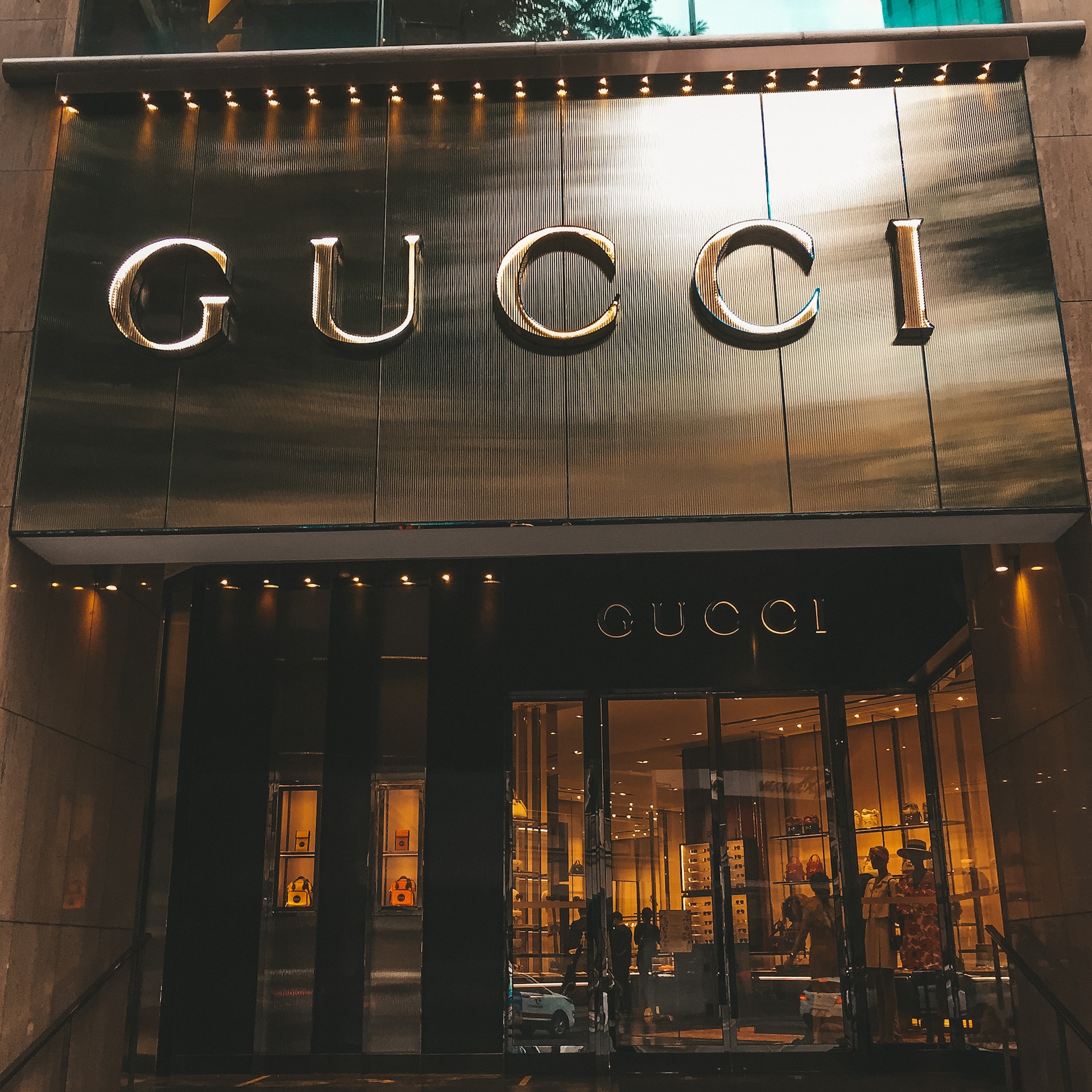Have you seen this Gucci shirt? Does anything seem strange about it to you? What if I told you that if you moved the dripping paint, the logo looked a bit different?
As it turns out, it wasn’t even a Gucci shirt to begin with. This is a shirt sold by Nobuaki Kurokawa, a Japanese entrepreneur with a fondness for parody (the juxtaposition of the original version of a trademark with a usually humorous, mocking, or irreverent one). He filed an application to register the “CUGGL” logo as a trademark with the Japanese Patent Office (JPO) in October of 2020. This led to a string of proceedings in which Gucci fought to stop Kurokawa’s use of the CUGGL name. On July 12, 2022, Gucci lost – in Japan, at least. Let’s take a closer look at why the Cuggl name has survived for now, and what might have happened had the case taken place in the United States.
Making a Mark
Trademarks are a type of intellectual property consisting of words, phrases, symbols, logos, designs, or any combination of the above (sometimes called “marks” for short) that identify the source of a good or service and distinguish that source from others in the marketplace. Importantly, trademarks only offer protection against other similar trademarks when there is confusion by consumers. Even if you had the trademark name “Apple” for selling computers, someone else could use the same name for selling coffee since consumers are unlikely to be confused.
In the United States, Gucci has over a hundred different trademarks, all protecting different aspects of the goods and services they sell. They have federally registered trademarks (marks that have passed the federal registration process and are granted national rights) to protect “Gucci” for handbags and purses, “GG” for tote bags and suitcases. The list goes on.
Gucci is very proactive in protecting its intellectual property. It came as no surprise that the Italian fashion house stepped in to oppose registration of the CUGGL mark, meaning that they tried to prevent the CUGGL mark from being registered on the grounds that it would hurt their business. In this case, they feared that consumers would be confused about which brand the shirts came from and that Kurokawa would exploit the confusion to profit from recognition of the Gucci name.
How Trademark Registration Works
Let’s consider what would happen if the same registration had taken place in the U.S. The process of registering a trademark in the United States takes place over several months. The United States Patent and Trademark Office (USPTO) assigns an attorney to each applied-for trademark, who reviews the mark and determines whether it is eligible to be registered. Typically, to be registered a mark must show: 1) that it’s being used in interstate commerce (or that it will be used in commerce in the future), 2) that the mark is distinctive enough to identify a particular source of goods and/or services, and 3) that the mark isn’t barred by law (this is called being “statutorily barred”). Assuming there are no issues preventing the mark from being registered, the attorney will allow the mark to be published in the USPTO’s “Official Gazette,” a publicly-accessible list of all marks waiting to be registered. Marks are published in the Gazette for thirty days. During this time, anyone can oppose the registration of the mark if they would be harmed. Typically, this means that the mark could cause confusion, weaken, or tarnish another mark, putting their business in harm. Harm to a business in this context means a variety of things. This may include a business losing sales because consumers are mistaking the company’s products with another, that the name of a business loses value because other businesses have similar ones, or that a company’s reputation will be hurt because another company with a similar name sells inferior products or does bad things. One of the most common reasons for opposing a trademark registration is the same reason Gucci opposed CUGGL in Japan: “likelihood of confusion” with an existing mark.
What’s Likelihood of Confusion?
At face value, “likelihood of confusion” is simple. If one party has a registered trademark, they have the right to oppose the registration of a similar mark being used for the same goods and services. For example, you would be unable to register the trademark “Apples” for computers because it would be confusingly similar to the well-established tech brand. Trademark examiners, including the examiners from the JPO and the USPTO, assess a variety of factors to determine if two marks are confusingly similar. Two commonly referenced factors are 1) whether the marks are similar in appearance, sound, and connotation, and 2) the relatedness of the marks’ associated goods and services.
The second factor is easy to analyze in this case. Gucci sells clothing, including t-shirts with the Gucci trademark. The CUGGL trademark is also printed on t-shirts for sale. The goods are identical for the two marks. Analyzing the first factor, though, is where things become tricky.
Even though the CUGGL mark appears in the same font as Gucci’s iconic logo, the names “Gucci” and “Cuggl” don’t resemble each other at all. They don’t sound the same, they don’t look the same, and they don’t have the same connotation when a consumer looks at them. Gucci tried to argue in its opposition that the inclusion of the paint on the bottom of the mark made distinguishing the “CUGGL” mark from the “GUCCI” mark more difficult. Gucci even pointed out that in commerce, Kurokawa was printing shirts with much more paint covering the word “Gucci” to confuse consumers into thinking it was a GUCCI shirt. The Japanese Patent Office wasn’t convinced. It found that there was no likelihood of consumer confusion between “Gucci” and “Cuggl”, dismissed Gucci’s opposition, and declared that the CUGGL mark was valid.
Now What?
I think Gucci has a much better argument that the “Cuggl” mark constitutes trademark infringement. This is true in both the United States and in Japan. In the U.S., trademark infringement creates liability for anyone who copies or imitates a registered trademark for use in commerce in a way that is likely to confuse consumers. Japanese patent law similarly prevents anyone from using a trademark similar to a registered one on goods or in commerce.
Gucci has a strong case that Kurokawa is infringing on its registered trademarks in Japan. Viewing the t-shirts Kurokawa sells, the “Cuggl” name is virtually indistinguishable from the Gucci brand unless you are aware that the shirt is meant to be a fun parody of the more-famous Italian brand. Speaking personally, I’m so out of the loop when it comes to fashion that I would interpret Kurokawa’s t-shirts as a new “avant-garde” Gucci style that I’m too unfashionable to understand.
Too Big to Fail?
Is there anything else Gucci could have done? In the United States, at least, Gucci could have opposed registration of the CUGGL mark based on “dilution”. Federal trademark dilution allows the holders of famous trademarks to stop the use of other marks that might weaken, or “dilute,” the strength of their brand – even if there is no likelihood of consumer confusion. This is because the more similar names there are to a famous brand, the less value the brand name has in distinguishing itself from others. For example, dilution would prevent me from registering the trademark “McDonald’s Sneakers” as the manufacturer of sneakers even if no consumer thought I was affiliated with the larger, internationally recognized McDonald’s.
Nobody would think that I was affiliated with McDonalds. That’s not what dilution is about, though. Imagine if there were dozens of “McDonald’s” in lots of different goods, including planes, cars, and laundry. Then the original McDonald’s name wouldn’t have as much value. Japanese trademark law has a similar provision but uses the wording “widely recognized” instead of “famous.”
Had this case taken place in the U.S., it’s arguable that Gucci could have opposed Kurokawa’s mark on these grounds. U.S. law specifies a number of factors for courts to consider in determining dilution by blurring, as in the example here. Some factors include the degree of recognition the famous mark has and whether the user of the potentially infringing mark intended for their mark to be associated with the more famous one.
Again, it’s fuzzy whether this argument would have succeeded the mark because the entire “Cuggl” name was visible when the mark was published for registration. It would be difficult to argue that Kurokawa intended for his mark to be associated with Gucci when the word “Cuggl” is almost entirely visible. It’s the use of the mark on the shirts that’s the issue here.
It’s Just a Prank, Though
Legalese and “likelihood of consumer confusion” aside, it’s obvious that Kurokawa knew exactly what he was doing. Need more proof? He’s sold other parody shirts, sometimes using the same trick, imitating a variety of different brands. He even lost a similar dispute before the Japanese Patent Office earlier this year.
Whether the CUGGL mark is a parody or not isn’t the issue. The question is, how does parody work in trademark law? Parody turns a “likelihood of confusion” analysis on its head. When assessing the likelihood of confusion between two marks, typically the first question to ask is, “how similar is the connotation?” With a parody, however, the entire point is to conjure up the mental image of the other trademark. There’s supposed to be a similarity. If a consumer doesn’t recognize the brand being parodied because it’s been modified to be dissimilar, they’ve either missed the joke, or the parody has failed. In the United States, whether a name is a parody or not is a key factor in assessing the likelihood of confusion between two very similar, if not identical marks for a claim of trademark infringement. If it is considered a parody that is actually criticizing the original, courts typically find no confusion since the parody tends to reinforce the original, rather than cause confusion.
Parody is also relevant to dilution. And, unlike in the case of trademark infringement, it can be a complete defense to dilution so long as the parody isn’t for commercial use and isn’t being used as a registered trademark. Because Kurokawa is using the CUGGL name both commercially and as a registered trademark, he wouldn’t be able to claim parody as a defense.
I don’t think it’s a stretch to say that the CUGGL shirts are out-of-line as far as parody goes. There’s a difference between using a play-on-words clearly meant to be a playful spin on popular brands (this one is my favorite) and covering half of a word to transform it into another brand. In the latter case, you could argue (as Gucci does) that use of the name is preying upon consumer recognition of a more famous brand. Even though I don’t think the parody is malicious in nature here, it probably goes too far. I also doubt the JPO would construe Kurowaka’s parodies as trying to prey on Gucci’s reputation in a malicious way, especially given that Kurokawa’s parodies have appeared in proceedings before the JPO before.
Next Steps
Given that Kurokawa runs a small business local to Japan, it’s unlikely that Gucci will ever need to address this “Cuggl” issue in the United States. It’s impossible to say for sure what would have happened had the case been tried at the USPTO. Even though trademark law exists around the world, countries can come to different conclusions despite the laws being similar. For now, we’ll need to wait and see how Gucci handles this parody situation in Japan and whether other companies affected by this type of parody respond in a similar way.

Connor Druhan
Associate Blogger
Loyola University Chicago School of Law, J.D. 2024
